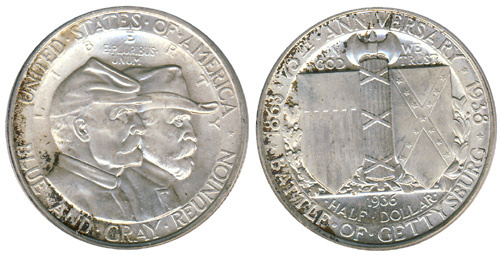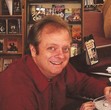The Last Reunion (part 4)
Note: As the publication of my new book, Clay Soldiers: One Marine’s Story of War, Art, & Atomic Energy draws closer, I thought that I would give you a preview of the book by publishing the first chapter. The story is a biography of Chuck Caldwell, a WWII Marine who fought at Tarawa and Guadalcanal. He also worked in Nevada with the above-ground atomic bomb tests, attended the 75th, 100th, 125th and 150th anniversaries of the Battle of Gettysburg, and is a sculptor of miniature figures that are highly sought after. If you are interested in pre-ordering a copy of the book at a 25% discount off the cover price and free shipping in the U.S., contact me at jimrada@yahoo.com. As always, let me know what you think.

The limited-circulation half=dollar coin issued in honor of the 75th anniversary of the Battle of Gettysburg
For some, Gettysburg held such a special place in their hearts and minds that they wanted to die on the battlefield. William W. Banks, a veteran who served with Company H, 18th Alabama Infantry, sent the Quartermaster General of the United States a telegram saying that he represented a group of veterans “do desire to remain here on this hallowed hill till Gabriel shall call us to that eternal party where there is no strife, bitter hate, nor bloodshed and we are one for all and all for one.”
Because of his father’s efforts to help Chuck meet living Civil War veterans, Chuck had actually met some of these men before, especially if they lived fairly close to Orrville. While those meetings stuck out in his young memory, the veterans rarely remembered meeting one particular young boy for a few minutes.
“They were close to 100 years old,” Chuck said. “They wouldn’t remember a little kid.”
One young attendee names John Stonesifer remembered the veterans as being grumpy without much to say.
That didn’t stop Chuck from approaching each veteran whom he could find. He carried his Brownie camera and an autograph book and looked more like a cub reporter than a tourist.
He would introduce himself and ask the veteran to sign his name and write the outfit that he had served in during the war and his hometown. Chuck also asked his father to take a picture of the veteran and Chuck. The brown-haired and brown-eyed Chuck looks very young in the pictures standing around five feet tall and as thin as a rail. He would be asking the veteran and questions he could think of whether it was about a particular battle, military life, or their life after the war.
One of the men whom Chuck met was John C. Smith of Meridian, Mississippi. The 108-year-old veteran had fought with the 46th Georgia as the Confederates charged Little Roundtop at Gettysburg.
“Somewhere in that furious charge across the valley, a spent bullet thudded into Smith’s cheek and he spit it out into his powder-blackened hand and went on to fight across the hill top and, finally, to give up up to the Union reforcements,” The (Circleville, Ohio) Daily Herald reported.
Chuck was enraptured with the stories the veterans told him and he could have listened to them for days on end. However, his camp tour was somewhat hampered by rain in the late afternoon and evening of Friday, July 1. Though the rainfall kept the temperature down, it also sent many people indoors. When the rain started, the camp headquarters sent a truckload of umbrellas to the veterans’ camp. More than 2,000 umbrellas were distributed to veterans so they could continue touring the town in buses that were also provided by the camp headquarters.
One of the first veterans whom Chuck met during the reunion was ninety-one-year-old Henry Rogers of Santa Monica, California. Rogers showed off his patriotism during one of the bus tours on the battlefield when he stood up and recited Lincoln’s Gettysburg Address to the cheers of the other riders on the bus who were nearly all Civil War veterans themselves.
Rogers had served as a dispatch orderly with the Fortieth Illinois Infantry during the war. Three of his brothers had also served in the same company. During the Battle of Kenesaw Mountain in Georgia on June 27, 1864, Rogers and his brothers had charged against a regiment of which their uncle was a soldier.
Rogers’ wife, Elizabeth, had accompanied her husband to the reunion and served as his attendant. She was seventy-eight years old, but still in good enough health to take care of her husband and serving as his attendant allowed them to share the same tent in the veterans’ camp. Chuck struck up an acquaintance with Rogers corresponded with the aged veteran until he died on November 20, 1938.
The big feature of July 1 was the opening ceremony at the Gettysburg College Stadium at 2 p.m. featuring U.S. Secretary of War Harry H. Woodring as the main speaker. One of the other speakers during the ceremony was the Rev. John M. Claypool of St. Louis, another one of the veterans whom Chuck met and had sign his autograph book. Claypool was the commander of the United Confederate Veterans and a descendant of John Hancock.
During his remarks, which were broadcast over national radio, Claypool good-naturedly noted that if the South hadn’t surrendered in 1865, it would have continued fighting using guerilla warfare still today, but Southerners had been too high-minded to continue fighting a lost cause.
“We can’t hold anything against each other,” Claypool said. “I speak as the representative of real Americans and as a real American myself. God bless you all.”
[i] Unsigned article, “Veteran Asks Permission to Remain at Gettysburg Until ‘Gabriel Shall Call Us’,” Unknown publication, July 7, 1938. This newspaper clipping is part of the 75th anniversary folder in the vertical files of the Adams County Historical Society.
Author interview with Chuck Caldwell.
Abbey Zelko, “Gettysburg tourist recalls experience at 75th anniversary: Gettysburg 150,” PennLive.com (http://www.pennlive.com/midstate/index.ssf/2013/06/gettysburg_tourist_recalls_exp.html) accessed January 7, 2015.
Author interview with Chuck Caldwell.
Unsigned article, “Veterans of North and South Recall Gettysburg,” The (Circleville, Ohio) Daily Herald, June 30, 1938, 3.
Unsigned article, “Here and There With the Veterans,” The Gettysburg Compiler, July 9, 1938, 4.
Unsigned article, “Here and There With the Veterans,” The Gettysburg Times, July 1, 1938, 1.
Unsigned article, “Here and There With the Veterans,” The Gettysburg Times, July 1, 1938, 1.
Unsigned article, “Here and There With the Veterans,” The Gettysburg Compiler, July 9, 1938, 4.
Unsigned article, “Here and There With the Veterans,” The Gettysburg Compiler, July 9, 1938, 4.





